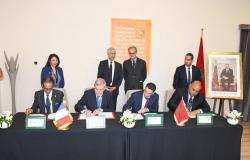Two farmers want to install solar panels on more than 50 hectares, between the municipalities of Versigny and Rosières (Oise). The project is strongly criticized by residents who denounce environmental and visual pollution.
The essentials of the day: our exclusive selection
Every day, our editorial team reserves the best regional news for you. A selection just for you, to stay in touch with your regions.
France Télévisions uses your email address to send you the newsletter “The essentials of the day: our exclusive selection”. You can unsubscribe at any time via the link at the bottom of this newsletter. Our privacy policy
“It will look like something 5.50 meters high. We will have large rows of trackers, that’s to say oriented solar panels, and we will hide them with embankments, a supposedly hedge and fences 2.20 meters high“, breathes Pascal Porquier. For two years, this resident of Versigny has been mobilizing against an agrivoltaic farm project: 70,000 solar panels, on 53 hectares.
The infrastructure would be located astride Versigny and Rosières, two municipalities in the Oise comprising approximately 600 habitants.
“The landscape will be completely remodeled. The picturesque landscape will disappear and there will be no going back. We are going to have so-called ‘declassified’ agricultural land, a wasteland […] We think about our daily lives during the work. OWe also think about our children: what will become of these signs in 30 or 40 years when they are obsolete?“, worries Pascal Porquier.
To make himself heard, he joined a collective called “Citizens Committed to the Defense of Valois – CEPDV” which today has several hundred opponents.
In the streets of Versigny (Oise), numerous banners recall the opposition of the inhabitants.
•
© Nagib Benghezala / FTV
The municipality of Versigny, which only has a consultative voice on this project, also proclaims its opposition. “Oalready the passage of the national 2. We also have the passage of the TGV. And there, the last corner of Versigny which is close to an area Nstop 2000, which is a truly protected area, we would like to distort it with such a project“estimated Guy Pierre de Kersaint, mayor of Versigny.
We are really on a magnificent landscape that we want to ruin through this agrivoltaic farm project.
Guy Pierre de Kersaint, mayor of Versigny
The councilor asks himself today: “This place can only be reached by small roads. campaign, Or two cars cannot travel at the same time. Why did you choose this place?one of the most isolated in the area, while we have abandoned places or wastelands on which we couldput up these signs?”
The agrivoltaic farm could see the light of day on the land of two farmers. One of them, Sébastien Vanlerberghe, in the business since 2011, explains why he chose this plot: “It is a sandy land. I planted orchards here and in ten years, I tore up ¾ of the surface because it would be necessary to put 500 millimeters of water to have a sufficient yield. Economically, it is not profitable.”
According to this farmer, kiwis, asparagus and even rhubarb could be grown under the solar panels. Sheep should also benefit from the shade.
While today we are having difficulty putting up hedges, we are going to put 3.4 kilometers of hedges, it’s colossal!
Sébastien Vanlerberghe, farmer
Léopold Santerre, project manager at TTR Énergy, a company which will exploit the energy produced by the panels, wants to reassure: “We will try to make the hedge as high as possible for masquery as much as possible, knowing that there is no visibility from Rosières and very little since Versigny.“
“There are no threatened species, we do not disturb the environments“, he continues. “Currently, game cannot pass because the area is fenced. With a corridor, we aim to recreate circulation. We are here to improve biodiversity and preserve it rather than the opposite.”
Simulation of the agrivoltaic farm which could be set up between Versigny and Rosières, in the Oise.
•
© TTR energy
The project, estimated to last one year, will require the passage of 400 trucks in total, “less than two per day“assure TTR energy. Ultimately, the infrastructure could supply 15,000 homes with electricity.
The public inquiry lasts until October 9. The decision will then come back to the prefecture. “We will fight so that this farm is not established in Versigny“, insists Guy Pierre de Kersaint, mayor of Versigny.
With Kevin Helies / FTV






